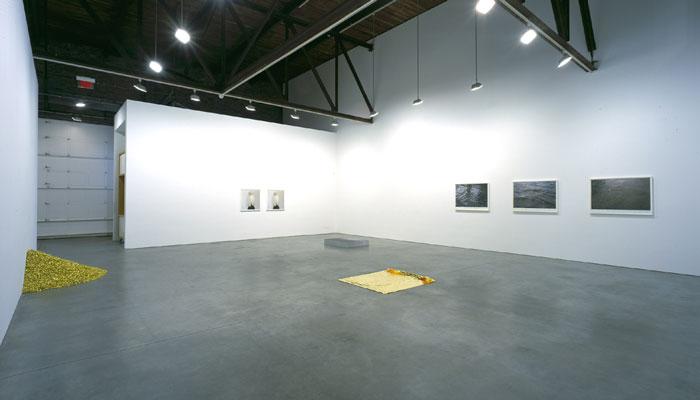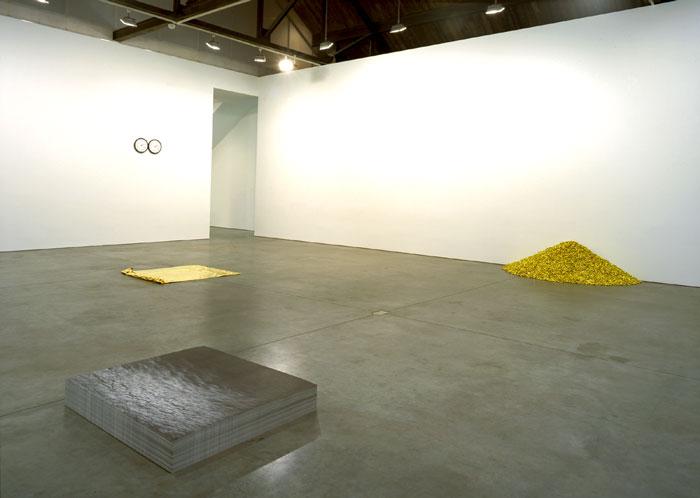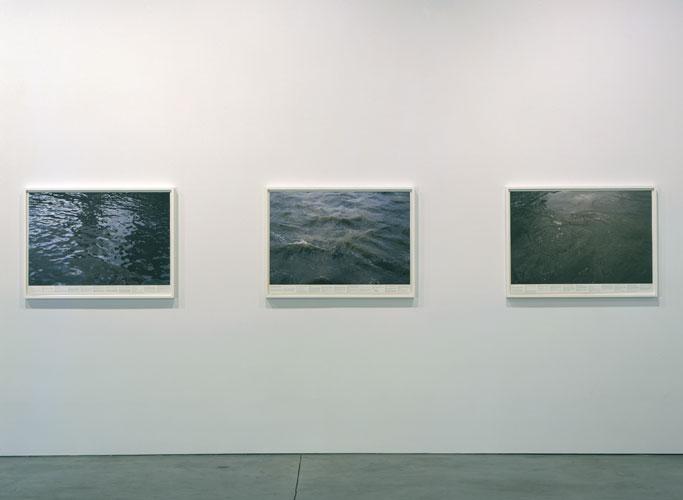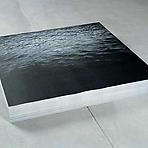Felix Gonzalez-Torres and Roni Horn
March 31 – April 30, 2005
Main Gallery
-

-

Felix Gonzalez-Torres
"Untitled" (Placebo-Landscape-for Roni)
Candies, individually wrapped in gold cellophane, endless supply
Overall dimensions vary with installation
Ideal weight: 1,200 lbs
ARG# GF1993-015
© The Estate of Felix Gonzalez-Torres -

-

Roni Horn
"Still Water (The River Thames, for Example) - Image D, O, I", 1999
Photographs and text printed on paper
30 1/2 x 41 1/2 inches each
ARG# HR1999-001
© Roni Horn
Andrea Rosen Gallery is delighted to announce the second in a series of two-person exhibitions exploring the affinities between Felix Gonzalez-Torres' and other artists' works.
As the following text by Felix Gonzalez-Torres illuminates, Felix was moved and influenced by Roni Horn's work well before he knew her. Subsequently, they became friends, sharing a dialogue of rare intensity. Felix was very good at maximizing the strongest aspect of each of his relationships, and he touched and was touched by many. However, there were very few people who Felix felt akin to in as many fields as he did with Roni-artistic, political, and personal.
The format of Felix's memorial was primarily the reading of letters exchanged between Felix and others. Roni was one of few people asked to speak-at Felix's request. The second text below is a portion of that poetic text.
excerpt from "1990: L.A., "The Gold Field", by Felix Gonzalez-Torres
from Earths Grow Thick, Wexner Center for the Arts Roni Horn exhibition catalogue, 1996
L.A. 1990. Ross and I spent every Saturday afternoon visiting galleries, museums, thrift shops, and going on long, very long drives all around L.A., enjoying the "magic hour" when the light makes everything gold and magical in that city. It was the best and worst of times. Ross was dying right in front of my eyes. Leaving me. It was the first time in my life when I knew for sure where the money for rent was coming from. It was a time of desperation, yet of growth too.
1990, L.A. The Gold Field. How can I deal with the Gold Field? I don't quite know. But the Gold Field was there. Ross and I entered the Museum of Contemporary Art, and without knowing the work of Roni Horn we were blown away by the heroic, gentle and horizontal presence of this gift. There it was, in a white room, all by itself, it didn't need company, it didn't need anything. Sitting on the floor, ever so lightly. A new landscape, a possible horizon, a place of rest and absolute beauty. Waiting for the right viewer willing and needing to be moved to a place of the imagination. This piece is nothing more than a thin layer of gold. It is everything a good poem by Wallace Stevens is: precise, with no baggage, nothing extra. A poem that feels secure and dares to unravel itself, to become naked, to be enjoyed in a tactile manner, but beyond that, in an intellectual way too. Ross and I were lifted. That gesture was all we needed to rest, to think about the possibility of change. This showed the innate ability of an artist proposing to make this place a better place. How truly revolutionary.
This work was needed. This was an undiscovered ocean for us. It was impossible, yet it was real, we saw this landscape. Like no other landscape. We felt it. We traveled together to countless sunsets. But where did this object come from? Who produced this piece that risked itself by being so fragile, just laying on the floor, no base, no plexiglass box on top of it…. A place to dream, to regain energy, to dare. Ross and I always talked about this work, how much it affected us. After that any sunset became "The Gold Field." Roni had named something that had always been there. Now we saw it through her eyes, her imagination.
excerpt from An Uncountable Infinity-For Felix Gonzalez-Torres-February 1996-by Roni Horn as read at Felix Gonzalez-Torres' memorial
A field of waves, perhaps an ocean: up close two different tiles recur to form a puzzle in which the image of water coheres. Among these tiles a labyrinth forms as my gaze loops between them and the water.
I am attracted to the little edibles, brightly colored candies mostly, as I partake of the metaphor that would send you around the world. I am a bumble bee-who would pollinate the world with you.
Images of sky, birds, water, murdered people, and certain colors stacked in measures of some critical mass. Each image forms a slice of some lesser but more acute mass that as a letter going out into the world whole, is only completed when it finds the place it is destined for. Each slice signals its own fate.
I am cast into an abrasive and exquisite consciousness.
Everything of me, everything outside of me is tempered by it.
I am laid open.
My skin, my consciousness are turned to glass.
The only risk left now is that of openness.
Framed by sky, buildings, roadways, and signs, the photographs out there on the street-between food and home-bring enigma near. And these enigmas recur. They are riddles that implicate public and private, you and me, us. They open up an Egypt-like space, when Egypt was mostly desert and when Egypt was mostly desert without parking lots, even vacant ones.
You are more nature. Your life is a rare form of transparency through which I have observed the world becoming more present to itself and through which I have become more present to myself. And in all of this, I recognize you, Felix, as another weather.
This exhibition is part of an ongoing series of five exhibitions addressing pairings of artists with whom Felix Gonzalez-Torres' work shared an affinity. Initiated in January 2005 with an exhibition of Felix Gonzalez-Torres and Joseph Kosuth, these exhibitions will be interspersed in our program over the next year and a half. Although each will take on its own form, for this exhibition Roni Horn has chosen the specific works; among others, the subject of Gonzalez-Torres' text, "Gold Field", 1982, and a piece Felix made in direct response to this work, "Untitled" (Placebo-Landscape-for Roni), 1993. Although it is not included in this exhibition, it is interesting to note that Roni Horn made a second gold field piece, "Gold Mats, Paired-For Ross and Felix", 1994-1995, after experiencing "Untitled" (Placebo-Landscape-for Roni).
We plan to publish a catalogue documenting this series with newly commissioned texts for each pairing. Additionally, in the fall of this year, we are anticipating the release of the monograph Felix Gonzalez-Torres edited by Julie Ault and published by steidldangin.
Felix Gonzalez-Torres: Specific Objects without Specific Form
Felix Gonzalez-Torres: Double
Published on the occasion of the first museum presentation of Felix Gonzalez-Torres's work in Asia at PLATEAU, and Leeum, Samsung Museum of Art, Seoul, South Korea, June 21 - 28 Sept. 28, 2012
Felix Gonzalez-Torres
Felix Gonzalez-Torres lived and worked resolutely according to his own idealistic principles, combining elements of Conceptual art, Minimalism, political activism, and poetic beauty in an ever-expanding arsenal of media, including public billboards, give-away piles of candy and posters, and ordinary objects--clocks, mirrors, light fixtures--used to startling effect. His work challenged the notions of public and private space, originality, authorship and--most significantly--the authoritative structures in which he and his viewers functioned. Editor Julie Ault has amassed the first comprehensive monograph to span Gonzalez-Torres's career. In the spirit of his method, she rethinks the very idea of what a monograph should be. The book, which places strong emphasis on the written word, contains newly commissioned texts by Robert Storr and Miwon Kwon, an introduction by Susan Cahill and an extended conversation with fellow artist Tim Rollins, as well as significant critical essays, exhibition statements, transcripts from lectures, personal correspondence, and writings that influenced Gonzalez-Torres and his work. Ample visual documentation adds another important layer of content. We see works not just in their completed state, but often in process, which for Gonzalez-Torres could mean the process of disappearing as viewers interacted with them.
Felix Gonzalez-Torres
Published on the occasion of the retrospective exhibition at the Serpentine Gallery, London, June 1 – July 16 2000.
Paperback: 88 pages
Publisher: Serpentine Gallery (June 2000)
ISBN-10: 1870814371
ISBN-13: 978-1870814379
Felix Gonzalez-Torres
Catalogue Raisonné in two volumes, published in conjunction with the posthumous 1997 traveling retrospective at Sprengel Museum Hannover, Germany; Kunstmuseum St. Gallen, Switzerland; Museum Moderner Kunst Stiftung Ludwig Wien, Austria.
Hardcover: 296 pages
Publisher: Hatje Cantz Publishers (July 2, 1997)
ISBN-10: 3893228837
ISBN-13: 978-3893228836
Felix Gonzalez-Torres
Originally published to accompany the artist's solo exhibition at the Guggenheim Museum in 1995, and reissued on the occasion of the 2007 Venice Biennale (June 1-November 21), where Felix Gonzalez-Torres would represent the United States.
Written by Nancy Spector in close consultation with the artist and reflecting and expanding upon his ideas at the time, Felix Gonzalez-Torres presents a thematic overview of the artist's rich, many-layered practice, including the signature paper stacks, candy spills, light strings and billboards--and demonstrates his continued resonance today.
Nancy Spector is Chief Curator at the Guggenheim Museum, New York, and U.S. Commissioner to the 2007 Venice Biennale.
Hardcover: 228 pages
Publisher: Guggenheim Museum (May 1, 2007)
ISBN-10: 0892073624
ISBN-13: 978-0892073627
Felix Gonzalez-Torres
Published on the occasion of the traveling exhibition, Felix Gonzalez-Torres at The Museum of Contemporary Art, Los Angeles. April 24 – June 19, 1994. Co-organized by Amanda Cruz, Ann Goldstein and Suzanne Ghez; The Hirshhorn Museum and Sculpture Garden, the Smithsonian Institution, Washington, D.C. June 16 – Sept. 11, 1994.; The Renaissance Society at the University of Chicago, IL., Oct. 2 – 6 Nov. 6, 1994
Paperback: 80 pages
Publisher: Distributed Art Pub Inc (Dap) (June 2, 1994)
ISBN-10: 0914357352
ISBN-13: 978-0914357353







